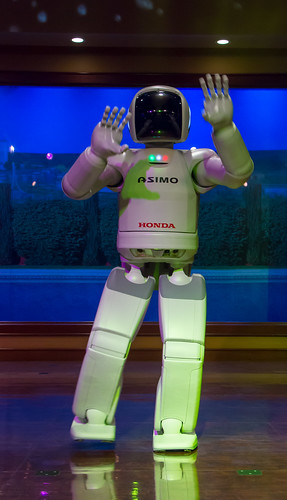 Robots are going to eventually replace humans in a vast array of jobs. There is currently robotics being implemented into jobs that previously posed a risk of injury to human operators. Robots can be programmed to do a variety of tasks, from handling repetitious manufacturing to stocking shelves at the local grocery store. Robots are pre-programmed, are sometimes built to mimic the human form, have sensors that allow them to detect and interact with their surroundings and can perform intricate, hand-like motions.
Robots are going to eventually replace humans in a vast array of jobs. There is currently robotics being implemented into jobs that previously posed a risk of injury to human operators. Robots can be programmed to do a variety of tasks, from handling repetitious manufacturing to stocking shelves at the local grocery store. Robots are pre-programmed, are sometimes built to mimic the human form, have sensors that allow them to detect and interact with their surroundings and can perform intricate, hand-like motions.
Fields Where Robots Currently "work"
Although the utilization of robots in the workplace poses a risk of danger to humans, there are still a number of common places where robots are being used. Some of the industries where robots are being utilized include automobile manufacturers, welding industry, painting industry and electronic manufacturing.
Possible Positions Replaceable by Robots
It is possible that a large portion of many jobs that are held by humans will be filled by robots. The primary reason is that machines can be programmed to produce a larger quota than humans, and they don't get bored or call in sick. Some employees are at a greater risk than others of being replaced by a robot including:
- Pharmacists. Robots can be programmed to sort, package and dispense each individual prescription. Robots are currently being used in a few hospitals, such as UCSF. The robots currently in use are able to sort the patient's pills into doses for a 12 hour period and attach a bar code, which allows nurses to scan the medications and have the correct dosage for each patient dispensed when the patient's medication is due.
- Cashier. Grocery and department stores are already gradually replacing cashiers with self-checkouts and although they have some irritating mishaps, such as occasional problems reading a bar code, they do help the check-out lines move quicker.
- Bank tellers. ATM's are already in almost every mall, on street corners and outside of banks. Eventually everything you can do inside the bank with a teller, you will be able to do from an ATM.
- Surgeons. Robotic surgery is already being utilized in a variety of procedures, but soon robots will be replacing surgeons by doing a large majority of surgical procedures, because there are smaller incisions, quicker healing times and reduced blood loss with robotic surgery.
- Child care providers. Many people expect robots to replace babysitters within the next decade. Just like a Hollywood film, robotic babysitters will remember your address, your children by name, as well as entertain and provide protection for them when they are in their care.
Business owners, especially those who own a factory or machine shop, are leaning towards the machining technology of the future for a variety of reasons. It is inevitable that robots will soon take over in a number of workplaces. They will become popular among business owners because of their thought efficiency. Many companies will eliminate labor costs as well as employee training costs. However, there are several jobs that a robot most likely will not be able to replace you with, such as an artist or other creative type of work that requires abstract thinking and/or drawing. A robot is preprogrammed to the task at hand, so they will not be able to brainstorm or implement a change in plans. One of the main distinctions between robots and humans is communication. A robot could speak, but it cannot fluently communicate with another human.







